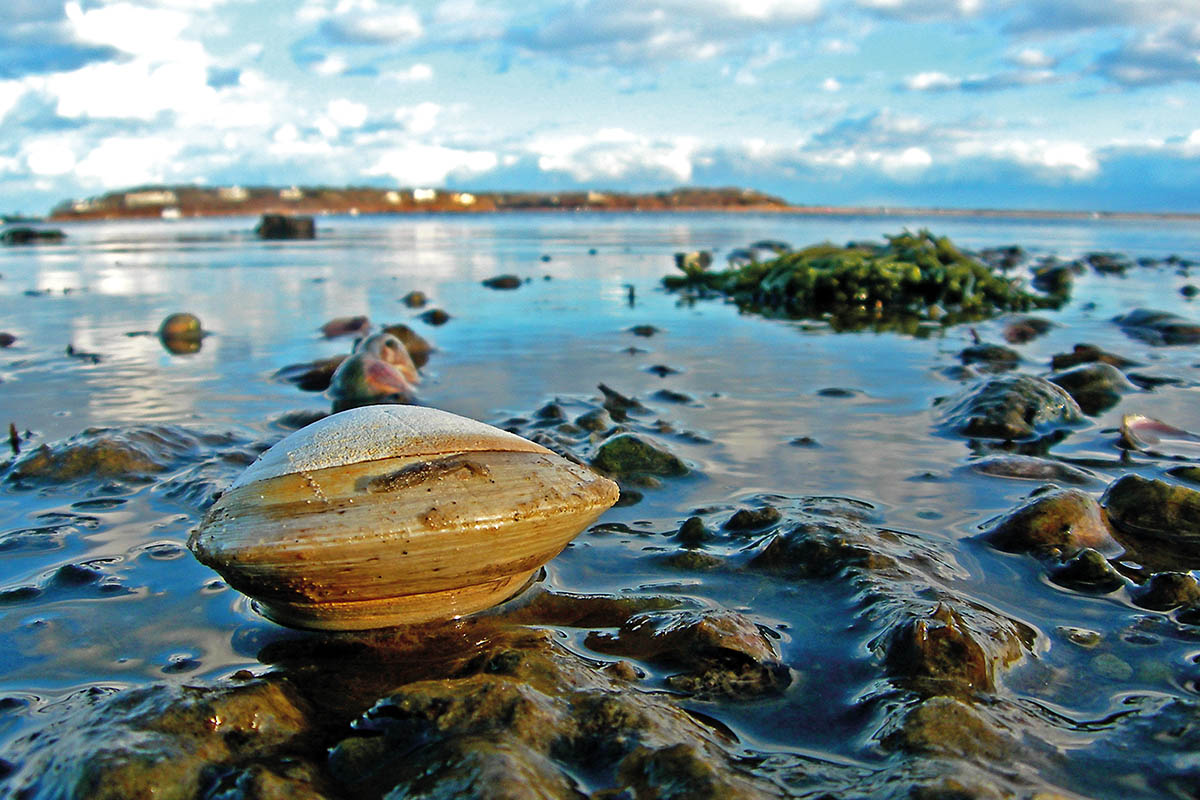
Marine biologist and published poet Fiona Gell grew up on the Isle of Man and later returned to help set up the island’s first marine reserve. She tells the story in her recently published book Spring Tides. In this extract, she describes a dive where she found a previously unknown colony of one of the planet’s longest-living creatures – the quahog
Some dives are more dramatic than others. In 2007 I was in the shallow, sheltered waters of Laxey Bay under the dramatic cliffs of Garwick. These dives were to survey for scallops after a reseeding exercise a few weeks earlier. Hundreds of baby scallops with numbered tags glued on were scattered from the fisheries protection vessel, Barrule, and we needed to check they’d settled on the seabed. We also had a good idea of the location of an inshore eelgrass meadow and were exploring the edges of that too. The inner bay was protected as a fisheries closed area (to allow scallop populations to recover from over-fishing) and additional ecological information would also help inform the future management of the area.

We had a rough plan, to do our fifty-metre transect, paying particular attention to scallops and habitat. Near the beginning of the dive my dive buddy started to pick up the odd bit of coal. Coal on the seabed is often the sign of an historic shipwreck – either the cargo of boats that didn’t make it into port, or paddle steamers that sank with their fuel unburnt. I kept my eyes open for the dark pebbles worn smooth by over a century on the seabed, and other evidence of shipwreck, while I recorded the ecological information. I was scribbling in pencil on my white plastic slate – seabed type, habitat and any creatures on the bottom or in the water column. Sometime in the first half of the dive, the current began to pick up. It was taking us offshore. Gradually we were forced to stop swimming against it and relaxed into moving with the tide.
Then, emerging from the sand ripples on the seabed I began to see arching black crescents. I managed to hang on to a rocky outcrop long enough to have a closer look and saw that it was clearly a bivalve, the shell a little open like someone just about to speak, with reddish-gold flesh exposed and the distinctive pale siphon visible. I’d never seen one underwater before, but the thick black shells could only really be ocean quahog. Scientists now use the information encapsulated in the shells of these long-lived and elusive molluscs to recreate historic climates. They are the longest-lived non-colonial animals on earth, and one Icelandic specimen was found to be 507 years old. I touched my buddy’s arm with my black-gloved hand and pointed. He turned and swam into the current to inspect the shell and then raised his eyebrows at me inside his mask. Concentrating on spotting and recording the quahogs as we flew over them became the perfect distraction from my mounting concern about how far and how deep this current would take us.
Laxey Bay had seemed calm and sheltered as we’d gone into the water but the speed at which we were moving meant that I’d no idea where we might end up. As the current picked up, I glanced at my buddy every so often. He seemed completely at ease, pointing out the quahogs and still picking up the odd piece of coal, and popping it into his BCD pockets.
I was breathing more quickly now. My air was beginning to get low. I showed my dive buddy my gauge. He signalled to me for another five minutes. I concentrated on breathing more slowly to conserve my air. Now, in places we were coming across little clusters of quahogs, three or four together. By this time I felt like marine tumbleweed, tipping and twisting and trying to keep my gauges and my limbs in some sort of order. Our ascent wasn’t easy. I was conscious that we were difficult for the boat to spot. I’m always afraid of being hit by propellers, so I was trying to make a controlled ascent in the current, while constantly keeping an eye up above.
I was breathing rapidly and tense with concentration. At the surface, we were looking back at the bay, well outside its sheltered confines and out in open water. But the boat spotted us quickly and we were soon on board. When we looked on the map later, we’d travelled more than two kilometres in forty minutes. And we’d discovered a previously unknown and thriving population of the most long-lived creatures on the planet. These dark molluscs may have been filtering plankton in Laxey Bay when Shakespeare’s plays were first being performed and when the population of Laxey spoke only Manx Gaelic and wouldn’t have understood a word of them. Steaming back to Port St Mary, we drank sweet tea and talked quahogs and drift dives all the way home.


